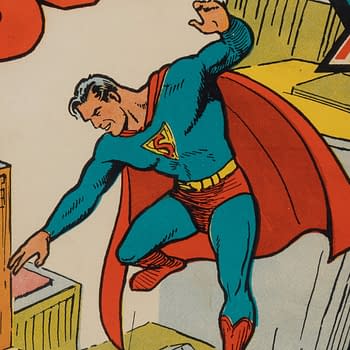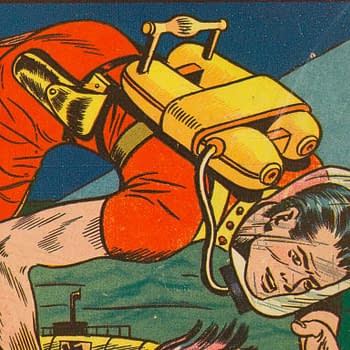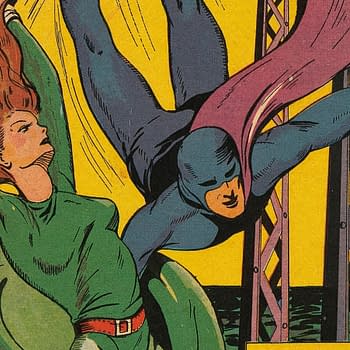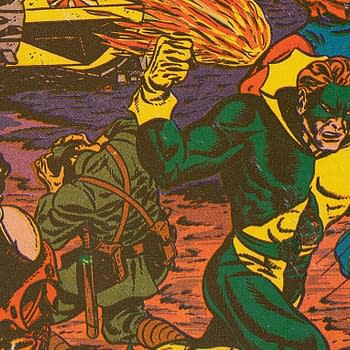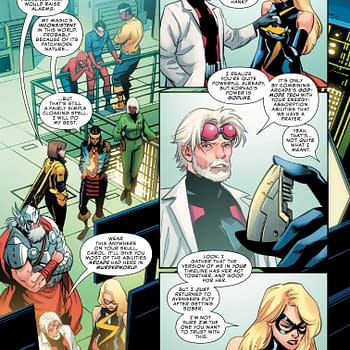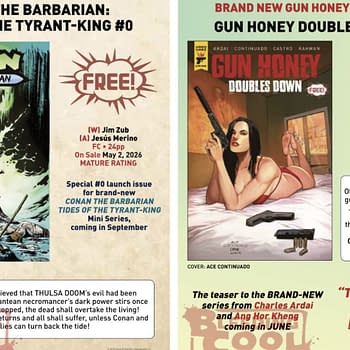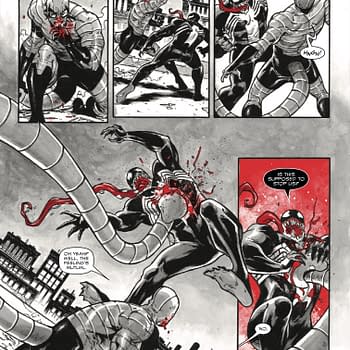Posted in: Comics, Recent Updates | Tagged: jack kirby, john romita, lawsuit, marvel
The John Romita Deposition For The Kirby Family Vs Marvel Lawsuit

John Romita is a legendary comic book artist who is most closely associated with his work on Spider-Man beginning in 1966, but he has had a wide-ranging career which began in the 1940s and has continued on in various capacities for decades. He also served a tenure as Marvel's art director. Last year, he and several others were called to give depositions in the Kirby family v Marvel case which involves the Kirby family's quest to terminate Marvel's copyrights on 45 characters Kirby helped create. Transcripts of these depositions have recently become public.
There's an incredible amount of material here so what I'm going to do is break down and excerpt stuff that jumps out at me.
If you're not familiar with this case, here is BC's overview on the matter and here is another recent development.
Thanks to Daniel Best for posting these public transcripts online. Please see his blog for a far more complete version. As he notes, this material is sure to be dissected at the atomic level for years to come.
Now, onto the deposition of John Romita:
On his current royalties:
JOHN ROMITA: Yeah, sometimes as little as 7 — 6 or $7,000 in a year, sometimes as much as 11, 14 depending on what's selling in the reprint department, and sometimes they take – they have made a series of collections and whenever I am in a collection, I get a check, sometimes $20, sometimes $200, and occasionally a bigger check when it's a big project.
On the creation process and who was involved:
Q: How — can you describe briefly what the process was for creating a comic book in the 1950s?
JOHN ROMITA: It was a shooting script similar to a film shooting script. It was a script with a title and a certain amount of pages allocated and they would say page 1, panel 1, the man walks through the door of the building and tells people "good morning everyone," that kind of thing. There are three people in the room. They give you — they gave you directions on what is appearing. Then they had a caption at the top nine times out of ten which said "early one morning," something like that, "next day," and then there were balloons to the characters. So I would have to decide on the size of the panels, depending on what was going on, where to place the captions and the balloons to the people, the dialogue balloons, and allocate the space for the illustration to explain what was happening in the story, to describe it.Q: Do you know who wrote those scripts?
JOHN ROMITA: There was maybe a half a dozen writers working for Stan at the time. There were western writers, there were mystery writers, there were war stories, romance. So I remember three or four names vaguely. Bernstein and — I don't remember most of them. Most of the stories I did Stan Lee would write.
Q: Who decided which artist got which scripts?
JOHN ROMITA: Stan Lee. He was the editor in chief. He was the editor and only writer on staff. The rest were — all these other writers were freelancers, like myself. They were home working, Connecticut, Carolina, California, wherever they were. So everybody was working at home except for Stan and a production manager, which was Sol Brodsky at the time, and his secretary. It was a very small operation up at Timely. Very small.
Q: After you did your drawings from the script, then what happened?
JOHN ROMITA: I would turn in the pencils so that they could have them lettered in ink, and then if I were inking it, I would get the pages back and I would ink them. After a while, especially when I was working at DC, I would pencil and ink them and leave space for a letterer to do the balloons, because I had become so familiar with the exact allocation of space, so it saved time. I didn't have to go back and pick up the pages again.
Q: Did you ever do that while you were at Marvel in the 1950s?
JOHN ROMITA: I think I probably did occasionally towards the end of the '70s — the first seven years when I got so familiar and Stan trusted me, I think I — he would say "don't bother bringing it in to be lettered, just ink it up and we will have it lettered." It was just a matter of expediency and saving time.
Q: Do you know who came up with the ideas for the stories?
JOHN ROMITA: I think — my memory is that the writers would submit a synopsis, like a half-a-page synopsis saying this is going to be a story about a cattle baron and rustlers and Indians and Stan would say "I like that story, add a pretty girl," that kind of stuff, and then they would write the story. Stan probably did all the selection. He might have — he might have even written some synopses himself and handed them out to writers to do this. Stan's brother was a young writer and he would do the same thing. He would give his younger brother a synopsis and the younger brother would do the script.
Q: Do you know his brother's name?
JOHN ROMITA: Larry Leiber. Lawrence Leiber, I guess.
Q: What would happen to the script when you brought it back after it was inked and penciled, penciled and inked?
JOHN ROMITA: Well, that's interesting. I assume they just destroyed it. I'm not sure. Maybe he just saved it for future use. I do remember after six or seven years that I would get eerily similar story lines. If I would do a western, I'd say to Stan, "you know, I could swear I did this story before." They would change the names — some writer would change the names and give — or maybe it's just a coincidence that they had the same idea five years later, but I did remember doing a lot of duplication. It was a sausage factory kind of thing, just churning them out. Very hard to keep tabs on things. Mostly memory.
Q: When you would bring the pencils back to the office, would anybody look at them?
JOHN ROMITA: Stan Lee.
Q: And what would he do?
JOHN ROMITA: He would tell me if there was anything that needed to be corrected. He would tell me "don't do this too much in the future, do more of this, do more of that." I remember one time I — for some reason I was doing a documentary type of thing or a science fiction type of thing and I did a little bit more elaborate rendering on the inking, which was a terrible mistake, because Stan Lee said "I love that technique" and I said "oh, my God," and he adventures in the west, love stories and war stories. So it was rather generic.
Q: Did you get a script when you were back — this is 1965 — at Marvel?
JOHN ROMITA: No. It was a plot. Wait a second. I'm not sure. I think it was a plot.
Q: And what do you mean by a plot?
JOHN ROMITA: A plot is either a written description of what the story is saying. At the beginning, there will be a fight for five pages, Daredevil will end up wounded, will go limping to his girlfriend's house and she will dress his wounds. Just a general sequence of events. Generally a page long, maybe a page and a half. Or like I foolishly did, a verbal plot. We would get together and trade ideas.
Q: Who would get together?
JOHN ROMITA: Stan and I would get together in a room and say, okay, the villain is going to be The Lizard and The Lizard is going to turn into The Lizard on page 3. He is a doctor, a one-armed doctor, and he turns into The Lizard and his family is kidnapped and he is now tearing up the city trying to find his family. That's about all we would get. And then I would have to do the nuts and bolts sequential between every episode — every little thing that happens you have to tie them together and make them sensible, so the artist's problem -I was terrified because I had always worked with a script. This was the first time I was deciding what was going to go on the splash, what was going to go on page 2, what was going to go on page 3. It was very difficult for me, very hard, but it turned out to be the greatest thing for the industry and for me, because the comic — the comic medium had been a script first and visual second and this made it visual first and script second, which was probably the greatest innovation, completely done for expediency sake. Had nothing to do with anything except expedience. They didn't — he didn't have time to write the scripts. So he was feeding plots to artists to keep them busy temporarily. At first he used to say "I will send you a script in two days, so start the story," and it ended up being the entire story would be verbally dictated over the phone or in a personal interview with the artist.
Q: Why would he switch from scripts to plots?
JOHN ROMITA: Only expedience. Because he was doing seven or eight major titles all by himself.
Q: And "he" is Stan?
JOHN ROMITA: He used to split — Stan Lee. Stan Lee would split the week sometimes and work two days home, three days in the office, sometimes two days in the office and three days at home, whatever it was. He would write four scripts in one day, bring them in the next day, and then the following day he would then stay home and do four or five more scripts. But when he was behind, when he couldn't keep up with the artists and he did not want the artists to stay idle, because the deadlines were looming, he would give them a descriptive verbal or written — quickly-written synopsis of what to do. And that's how the plot first and script second, script third came about, which was called the Marvel method, which I believe made the comic industry what it is today. I believe there would be no comic industry if it weren't for that.
On Stan Lee's conflicts with Steve Ditko:
JOHN ROMITA: I did twelve, thirteen, fourteen, fifteen, sixteen, seventeen, eighteen — I think I did from twelve to eighteen. Nineteen I was off the book and on Spider-Man.
Q: And why did you switch to Spider-Man?
JOHN ROMITA: He and the Spider-Man artist disagreed on almost everything.
Q: "He" is?
JOHN ROMITA: Steve Ditko.
Q: Okay.
JOHN ROMITA: Steve Ditko had started Spider-Man with him –
Q: With –
JOHN ROMITA: With Stan. I'm sorry.
Q: That's okay.
JOHN ROMITA: Stan and Steve Ditko were doing Spider-Man for 38 issues plus annuals, 40-plus issues, and it was the second most — second best selling book in the Marvel stable. Stan asked me to use Spider-Man as a guest star in Daredevil for two issues, number 16 and number 17, I believe, and I put Spider-Man in and drew him as well as I could and it turned out that he was feeling me out as a possible replacement. I didn't know that he and Ditko were at odds so extremely, but they ended up not being able to work together because they disagreed on almost everything, cultural, social, historically, everything, they disagreed on characters, so he asked me "do you think you could do the book?" I assumed foolishly that Ditko would not stay away too long, because if I would have had a hit series that was three years and growing in audience, I would have never left it, so I attributed the same kind of sense to him, which turns out he had no intention of coming back. I thought I was going to do a short couple of months fill in and I'd go back on Daredevil, once again showing I don't know what I am talking about. And I ended up doing seven straight years and maybe fifteen years on and off on Spider-Man.
On becoming a "de facto art director":
Q: How did it go when you first started drawing Spider-Man?
JOHN ROMITA: It was very difficult, because Ditko's — I felt obliged — I felt the reader needs not to have a jarring change on a hit book. If you are a Spider-Man fan and you are buying it for three years, I don't think you would like to see a different style and a different approach. I felt the obligation of all artists who replace another artist to simulate and use the same style, at least temporarily, at least for a while, and I didn't expect I would have to stay on it long enough, needed what we call the indoctrination, meaning the Stan Lee approach to comics and how to handle it, how to approach the story, the excitement level and the dynamics of the story, and I used to be able to slowly — slowly but surely I got used to every instruction Stan gave and I would start to do it whenever he wasn't around, so I became a de facto art director without pay, without portfolio, without anything. And –
Q: What were your responsibilities as the de facto art director?
JOHN ROMITA: Well, they were nothing written out. I just ended up doing some of the things that Stan would do if he were in the office. Whenever he was not in the office, they would come to me and ask me "tell this guy what Stan would like," and so young artists used to come to me and it led to eventually an apprentice program which I supervised later on after Stan Lee level.
Q: So when Stan was there you mentioned that one of your duties was a correction artist. What was a correction artist?
JOHN ROMITA: Sometimes artists would bring in the story and leave out something or put in something that he objected to and he would ask me to make a change.
Q: Stan would?
JOHN ROMITA: Stan Lee would ask me to -sometimes he didn't like a girl's face, some artists are very good at girls, at drawing girls, and some are not so good. So if a guy did a girl that he thought was not as glamorous or not as effective as it should be, he would ask me to make the changes. I used to change a lot of people's faces for which I got a reputation of being an egomaniac. They thought I was initiating it. I was just following orders like a Nazi guard. And so I — whenever somebody's costume was wrong or whenever the setting was wrong or if it was a night-time scene and it should have been a daytime scene, all of these little things fell into my lap to the point where we would then hire some people to be around to help out. More than one person was hired to help me out with that. I also was given the assignment of doing cover sketches.
done, then you can — then you know what costume to put on the person and what situation to do because it has not been done until the penciling gets done.
On the evolution of the Marvel Bullpen:
Q: And in the 1960s, the late 1960s, would anybody other than Stan have been giving you the ideas?
JOHN ROMITA: It's hard to tell when Roy started to make requests. Probably before 1970 Roy was asking for things too and we used to work together with cover ideas. Sometimes we would work out sketches in a very rough way and give them out to artists, each artist that needed a cover idea. 90 percent of the time it was Stan in the '60s. Once the '70s came Stan was not always in the office and always very busy probably as each conglomerate that took over the company — Marvel would have different demands on him and give him a different position. He would go from editor in chief to president of the company in some instances, so his duties changed and whoever was left with editor in chief assignment I would then be at his mercy and at his beck and call.
Q: At Marvel in the 1960s who was responsible for deciding which artists would draw which stories?
MR. TOBEROFF: Objection to 1960s as — do you mean after 1965 when he worked there?
MS. SINGER: You can answer the question.
JOHN ROMITA: Stan Lee decided. As far as I remember, in the '60s Stan Lee would decide. Later on when Stan was not in the office as much sometimes the production manager would make a decision like that, because he was keeping tabs on who was available and who had time, who was fast, who was slow. So other people did make that decision later on.
Q: Were there any other artists who were working in the offices full-time?
MR. TOBEROFF: Same objection. Vague as to time.
MS. SINGER: You can answer the question.
I couldn't take those weeks where I couldn't produce enough to pay my bills. So it was all rather casual. The same thing — Marie went from being a production person and a colorist to a penciler in a gradual circuitous way. Larry Leiber suddenly wanted to become an artist and he started — he gave up his writing assignments and became an artist. Herb Trimpe worked there. And we had all of the look of a bullpen, but it sort of like grew like a fungus. It didn't — it wasn't ever planned. It just happened. Things just occurred.
On creators' objections to signing checks with the work for hire disclaimer:
Q: Do you recall would there be anything printed on the check?
JOHN ROMITA: There was a disclaimer on the back. No disclaimer.
MR. TOBEROFF: Vague as to time.
MS. SINGER: You can answer the question.
JOHN ROMITA: It was — it was fairly clear. It was saying that we were giving up the rights to anything that was done in the books, the future rights to them, so we — I wanted to cash the check, so I signed it.
Q: I am going to show you something that, for the record, has already been marked as Plaintiff's Exhibit 2 at the deposition of Stan Lee on May 13, 2010.
Mr. Romita, don't worry about the front of this. I just would like you to turn to the last page of Plaintiff's Exhibit 2.JOHN ROMITA: The back of the old checks.
Q: Okay. I know this isn't your signature. It's a little hard to read.
JOHN ROMITA: No, that's John D'Agostino.
MR. TOBEROFF: I would like to object to this exhibit because the -despite the inferences in the affidavit, which I find somewhat misleading, the check is actually, I believe, a 1987 check. If you look at the markings on the back of the check, it says City National, JE-87, so it's a 1987 check we are talking about.
Q: So, Mr. Romita, I know it's a little hard to read, so, for the record, of the back of the check, we are looking at Plaintiff's Exhibit 2, says: "By acceptance and endorsement of this check, payee acknowledges,
(a) full payment for payee's employment by Marvel Entertainment Group, Inc., (b) that all payee's work has been within the scope of that employment, and (c) that all payees' works are and shall be considered as works made for hire, the property of Marvel Entertainment Group, Inc." Do you see that?JOHN ROMITA: Yes. I read it many times.
Q: And is that similar to what you recall being on the backs of your checks?
MR. TOBEROFF: Objection. Vague. "Similar."
JOHN ROMITA: Basically it's the same. Same — it always went over the same territory and to the point where some of my colleagues were threatening not to cash the checks.
Q: Do you recall approximately when it was that your colleagues were threatening not to –
JOHN ROMITA: I think somewhere in the late '70s. They would threaten, but, of course, they would cash the checks eventually. Barry Windsor Smith thought it was unreal. I don't know what he was creating, what he felt he was creating, but the point is they tried it. I never — it never occurred to me not to sign the check.
On the habit of artists writing dialog or notes in the margins of the original art for Marvel books:
JOHN ROMITA: The only thing we used to do, because we worked from a plot, we used to write notes above and below the artwork and sometimes in the margins to — we would make notes and say — to remind him what we had talked about in the plot and this is my response to it and this is how I'm building up to it. So yes, remember that this is — we are now going into the fight phase and such and such, on the next page we would go to — so there were instructions by the artists as a reminder to the writer what we plotted, or if we were deviating from it slightly. Say I needed to add a panel here because we forgot how he was going to get from the east side to the west side in thirty seconds. You know, that kind of stuff. So a lot of writers disregarded those things, and when you do the artwork, you are faced with the reality of actual bridges and connections.
You can't just make believe –Spider-Man used to swing to Manhattan from Queens, go on the rooftop, take an elevator down and come out as Peter Parker, and I used to tell Stan — and I was such a fanatic for believability and sense, common sense, I said, "Stan, what did he do, how did he — where is his costume?" He said, "its underneath." And then he would forget. Sometimes he would have him go into a doctor's office and take off his shirt and be examined and I would say, "Stan, he has got the costume on underneath." He never thought of those things. I had him so browbeat with my reality check that he once made me for a year take off Peter Parker's shoes and I had to put them on — tie the shoelaces and put them around his neck so that as Peter Parker he could walk up a wall, because somebody told him — after all the times I had tried to make him think realistically, somebody told him, "well, how can he walk up the walls when he has got shoes on?" His spider abilities doesn't — he should have even taken his socks off. The point is I had to do the damn shoes for at least a year or six months. That's the — I also created a web pack where Peter Parker would take his clothes and put them in a web sack and put them around on his back like a knapsack so that when he got to New York he could take his clothes out of the web sack, put them on and leave his — and go downstairs, you know. In other words, now at least you know he could put his clothes on. Where the hell were his clothes all the time? You know. So I was a realist and Stan was always — "it's not important. The reader doesn't think of those things." Well, I think of them. I can't stand it that way. So that's the kind of stuff we used to have. That's where all of the changes come from.
Q: So what would Stan do with notes or the dialogue in the margins?
JOHN ROMITA: I used to write notes that I thought were clever. I'd say "maybe he should say 'what's up'," you know, something like that.
They sounded clever to me while I was doing the drawing. 3 in the morning everything sounds clever. He invariably would not use them, and I asked him once "why wouldn't you use — why wouldn't you let him" — he said something similar. He said, "because I can't speak in somebody else's vernacular." He says, "when I am writing my characters, I am writing in Peter Parker's personality and Aunt May's personality and I write the captions in my personality. If I start putting your personality in there, I am going to confuse the reader." So he used to -he told me — he invariably did not use anything that was in the margins that was cleverly suggested by the artists, because he said he did not want to stray from his normal approach. He had a dialogue going with the reader. Saying "dear reader, this is your editor speaking right now." He used to do that. It used to drive me crazy. I used to tell him "you are puncturing the illusion." It's like opening a door in the theater and letting the sunlight in and everybody realizes they are watching a movie now. I said "you are ruining" — he said, "it doesn't matter. I am talking to my readers."
Q: Do you know whether it was just your dialogue he wouldn't use? Would he use anybody else's dialogue in the margins?
JOHN ROMITA: I don't think so.
MR. TOBEROFF: Calls for speculation.
JOHN ROMITA: I don't think so. I don't think he ever — I think he — more than once I've heard him saying he avoided anybody else's expressions in the scripts.
Q: Who had the final say on what the dialogue would be, what the characters would say?
JOHN ROMITA: Stan.
On working with Jack Kirby, Barry Windsor-Smith, and others:
Q: When did you first meet Jack Kirby?
JOHN ROMITA: Shortly after — between July of '65 and January of '66 I brought some artwork in and Jack was sitting doing a correction the way I eventually would do all the corrections on a Steve Ditko cover, Jack was making a change, and I was introduced to Jack Kirby, who ten years earlier, twelve years earlier had been my idol when I was a kid and Captain America came out. It was like meeting, you know, the president of the United States.
Q: Why would Jack Kirby have been making changes to a Steve Ditko cover?
JOHN ROMITA: Because of Stan's long-honored tradition. Whoever was caught in the office when he needed a change was subject to the assignment. If you came in, you had to have a pencil with you. If you didn't have a pencil with you, you were out of luck. But Jack was amenable to making the change. Stan didn't like something Ditko had done on the cover and Jack changed it. Whenever I — even in the first seven years before Marvel Comics existed I would go in and deliver a mystery story, four pages, and hope for another script. Stan would say, "while you are here, can you do me a favor and change — this is Arthur Peddy's romance story here. Would you change this expression, would you change this figure, would you add a car in this scene." He did it all the time. No pay. "Just do me a favor." You know, and the inference was you want a script, do me some corrections.
Q: Did you ever make any changes to any of Jack Kirby's work?
JOHN ROMITA: Yes. And it was hard for me, because I idolized the man's stuff. I used to change occasionally girl's faces. Now, Jack used to do girls that I loved. I loved his girls. But Stan used to find sometimes something that he didn't like, an expression, two wide a face, too narrow a face, mostly too wide, and he would ask me to adjust it. He liked the way I did one of the female characters in Captain America better than the way Jack did it, so I would occasionally change the faces. Much to my chagrin, people accused me of being an egomaniac, again, because they thought I was the one changing it. Since I was a de facto art director, they said, "look this Romita, he is changing everybody's work."
Barry Smith almost put a contract out on me because I changed somebody — a girl's face on a Conan cover. To this day I still don't know why he is talking to me. We are friends, but I know he wanted to kill me then.
Q: Whose idea were those changes? Were they ever yours?
JOHN ROMITA: Uh-uh, never. I would never change anybody — I had to change Jack Kirby's work, Gene Colan's work, John Buscema's work. I idolized all of these guys. I would — it violated me to have to do it. I cringed. And I will tell you, the worst thing is initially we didn't have the equipment or the technology to do it less obtrusively, because originally we didn't have photostats and Xeroxes to work with. I erased things. To this minute I -the hair on the back of my neck stands up when I am thinking I am erasing a Jack Kirby face and putting my face in there. That, to me, is a criminal act. I did it because I had no choice. Stan asked me to change it. We had no technology. As soon as I was art director and Stan was on the west coast and we had the technology to have a Photostat, I devised a system with iodine to erase things on a Photostat with iodine and I would get a clean Photostat, perfect surface, and eliminate a face. So I would take a Photostat of a page or a panel, I would iodine the face out, I would put in the face that stand wanted or the editor — Roy Thomas or whoever was the editor then, and we would paste that over the artwork. At least I could say to myself when the art goes back to the guy I idolized, he could peel it off and you could see his original art. Then I felt better. But until we had the technology, I used to actually deface artwork that I idolized. And it was not fun, but I did my duty as I was instructed.
On the value of original artwork, then and now:
Q: Did it ever occur to you not to do it if Stan asked you to?
JOHN ROMITA: It occurred to me, but I never figured it was worth it. You know, one thing I gotta constantly remind people of. I did not envision a world where anyone would not only care or even remember that there was a comic industry. From the '50s on I assumed the comic Stan were buddies. Every time he visited, "I want to give him a daily, I want to give him a Sunday." I would take one of my Sunday pieces of art and sign it "to Andre, John Romita." He would sign it, and we would give it to him. I gave away artwork that is now selling for $50,000. I gave them away in the office. That's my — that was my — my take on the future of comics and the future worth of the artwork was absolutely who is gonna give a damn about this. In five years nobody will even remember we lived here. So help me. That was my take. So as much as I cringed changing it, I never felt serious guilt because I thought who is gonna care. That's my defense. I mean, maybe I would still get convicted of a crime. I don't know. That would be my defense.
On how plotting sessions work:
JOHN ROMITA: I was present at at least two plotting sessions of John — Jack and Stan Lee. They were the same as my plotting sessions and the same as Gene Colan's and Herb Trimpe's and John Buscema. John Buscema actually did his plotting by phone, because he lived two hours away from the city. But anybody else who went in, Colan would come in, Jack Kirby would come in, I was at the office, we would plot in Stan's office, and with Stan and Jack, most of the time — some of the times Jack would -Stan would drive both of us home on a Friday night or whatever night he was in plotting. They would finish or almost finish and then Stan would say, "come on, I will drive you guys home." He would drop me off first and then he would take Jack, who lived about twenty minutes past me in the same general area of Long Island. So I was in the back seat of Stan's Cadillac on two occasions that I remember distinctly, maybe more, where they were continuing what they had not finished in the office, continued plotting.
I remember one particular Fantastic Four plot about the birth of the son of the two major characters in the Fantastic Four. Mr. Fantastic and The Invisible Girl were having a baby and it was a boy and they were discussing whether the boy would be gifted, a mutant like they were and gifted with powers and talents, or whether he would be a normal boy, and I remember the reference — I even referred to them and said it's like the Munsters. There was — in the Munsters television show they were all bizarre mutated people except for the little boy who was raised — or there was a girl. I think there was a girl. She was the only normal person. So I said you could make the kid a normal guy in a family of mutants. And then they said they considered that, and then said, "well, I don't know" — and I was thinking to myself, wow, wouldn't it be great if they had him and you never know if the kid has powers and slowly but surely he would exhibit — for instance, he would levitate a glass or something. And so I am thinking all these things while they are talking and I remember them talking. One guy would make a suggestion, Jack would say, "that's not a bad idea, but what if we did it this way," and then Stan would say, "okay, but only if we did it that way" and "only if we did it this way." They were both talking different plots and it's -and the reason I know it is because when Stan and I would plot, I foolishly did it from memory. I never recorded it. Gene Colan was his setting, I would do everything he would ask for, but I had to do the nuts and bolts of the story. When it comes to characters, he would ask me "give me a character called The Shocker." I would create — he would tell me the — he has the powers to shock people with electric bolts from his wrists. So he shocks people.
Q: Stan would tell you that?
JOHN ROMITA: Yeah, he would say that's what The Shocker is. So I would create a costume for it. I didn't create the name. I didn't create anything else. I didn't create the powers. I just created the costume. I put him in a quilted outfit, believe it or not. I thought it was going to be laughed at. Stan accepted. He was quilted so he could absorb his own shocks. The next time it would be The Rhino. He is a man in a rhino skin. He could drive himself through a wall. Just butt head right through a wall. I just did a guy in a rhino skin with his face showing through the open mouth of the rhino. Brilliant. Stan accepted it. And then he would take the character and make him valid. He would make him valid by his behavior, by his dialogue, by his — the results of what he does, the mayhem he caused, and he would give the guy a personality. That's all it was.
On lean times in the industry in the 1950s, and the Comics Code:
Q: "Around 1957 was when Stan and I were at our lowest ebb in our relationship. In the last year, he cut my rate every time I turned in a story. He was not even talking to me then. He was embarrassed, because he had given me raises for two years every time I went in, and then he took it all away. I went from $44 a page to $24 a page in a year."
Then Roy Thomas says: "As Gil was fond of saying, "comics giveth and comics taketh away."
And then Romita, that's you, says: "Virginia kept saying, "well, how long are you going to take the cuts until you go somewhere else?" And I told her, "I'll hang on, I'll hang on." Then, when it came time that he ran out of money and had to shut down, or cut down to the bone, I had done two or three days' work, ruling up the pages, lettering the balloons, and blocking in the figures on a story — and here comes a call from his assistant — she had beautiful bangs, beautiful brown hair, I forget her name, but she was adorable — and she says, "John, I have to tell you that Stan says to stop work on the Western book because we're going to cut down on a lot of titles." I said to her, "well, I spent three days on it. I'd like to get $100 for the work, to tide me over." She said, "okay, I'll mention it to Stan." I never heard another word about the money, and I told Virginia, "if Stan Lee ever calls, tell him to go to hell." And that was the last work I did for him until 1965."
Do you see that?JOHN ROMITA: Yes.
Q: Is that consistent with your recollection?
JOHN ROMITA: That's exactly my recollection. I would never forget that.
Q: Now, after you started working as a freelancer with Atlas in 1951, did you do freelance work for other comic book companies?
JOHN ROMITA: I did, yes.
Q: Do you remember some of the names of those companies?
JOHN ROMITA: The only company, I believe, was DC Comics. I might have done some Avon past in 1951 or 1952. I'm not sure. I don't believe so, because I was in the army and I didn't have a lot of time. I think I was just doing work for Stan Lee, but I did later on, after I got out of the army I did some work for DC, romance comics, while I was working with Stan.
Q: And when you were working with Atlas you had no written agreement; correct?
JOHN ROMITA: Correct.
Q: In 1958 was Atlas experiencing financial difficulties?
JOHN ROMITA: Absolutely.
Q: What was the reason for that; do you know?
JOHN ROMITA: Two reasons. Well, this may be my own — first of all, the comic industry was under fire because of an old crank who claimed that comic books led to juvenile delinquency and the comic companies pulled their horns in and tried to defend themselves and stammered their way through the congressional hearings and it looked very bleak for comics. They bailed themselves out by instituting a Comics Code Authority which they all put money up to create an impartial code authority which would pass judgement on comics and make them family friendly and child friendly.
The other problem was that all the companies were over-extended. They had too many titles and each one of their titles could only sell a certain amount because they were in competition with themselves. They would put out fifty to sixty titles, mostly garbage, because you can't get fifty or sixty good books out, there aren't good enough – enough good artists. I fought for thirty years to have Marvel cut down on the amount of books they put out, because it was always suicide to over-produce. So between the over-production and glutting the market with garbage and the Senate hearings, comics was about to go under. That's why in '58 Marvel — Marvel Comics – Timely Comics shut down to two books from fifty titles.
Q: From fifty to two?
JOHN ROMITA: At least — two may have been an exaggeration, but they cut down to the bone. There was only like two or three artists working. Dick Ayers and — I have forgotten the other guy. Don Heck. These were the only guys that Stan kept on. I was not one of them.
Q: Would you say they cut down by —
JOHN ROMITA: By just letting people go.
Q: By about 90 percent or more possibly?
JOHN ROMITA: I don't know how many artists he had. Whatever it was, it was dozens down to two, or a dozen artists down to two, whatever it was, yes.
Q: Oh, excuse me. "And he said, "nah, I don't think so — they are looking for anybody."
JOHN ROMITA: "They aren't looking."
Q: "They aren't looking for anybody." He never even got off his ass to introduce me to anybody. He told me, "listen, you're a freelancer. You're not on contract"."
JOHN ROMITA: Yes.
Q: Does this comport with your understanding of how things were back at those days?
JOHN ROMITA: This was a shining example to confirm my opinions. Yes. And he was a prize package. He didn't last long.
Q: But as a freelancer you were free to work for whoever you wanted to?
JOHN ROMITA: Sure, as long as they were not putting you under kind of — occasionally an editor would tell you, "if you work exclusively for me, I will give you first crack at the scripts," which was a verbal promise that they couldn't always keep, but some people fell for it. I think Stan Lee said that to me when I went and did romance stories for DC. He put me in that spot.




